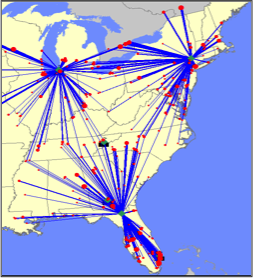 The “defining moment” of your supply chain performance is the time and place availability of products in response to customer demands for shorter lead-times and lower prices. This is all in the backdrop of aggressive competition and escalating operating cost for facilities, equipment, fuel, systems, and insurance.
The “defining moment” of your supply chain performance is the time and place availability of products in response to customer demands for shorter lead-times and lower prices. This is all in the backdrop of aggressive competition and escalating operating cost for facilities, equipment, fuel, systems, and insurance.
A logistics network optimized to improve customer service and minimize operating cost is a fundamental requirement for the winning enterprise. Determination of the network is a process incorporating strategic and tactical elements. Our four-step approach provides our customer with a balanced approach to the art and science of network design.
Business and Logistics Strategy
- The business and customer requirements that create competitive differences are defined in terms of logistics support and functionality.
- The value of the competitive advantage is described and quantified.
- The logistics support and functionality are defined in terms of the current capability and relative costs.
- A conceptual description and model of the network strategy.
Data Collection and Organization
- Clearly define the elements of data to be collected.
- Collect, organize, and analyze historical production, inventory, and shipment data.
- Use assumptions, forecast, and logistics strategy elements to transform the historical data to the best, worst, and most likely picture of the future.
- Preparation of the data to be used in the numerical network modeling.
Network Modeling
- Select the appropriate modeling tool.
- Model the current network to prove the accuracy of the data and model rules. This creates a baseline to which alternatives will be compared.
- Model alternatives and scenarios that support the scenario of the model. Make adjustments to each scenario to test sensitivity volume, cost, and service drivers.
- Fine tune the alternatives providing the desired results until the optimum solution is reached.
- Define the benefits and risks associated with each alternative. Document the trade-offs between the alternatives.
Define the Recommended Network
- The strategic “fit” of the recommended network.
- The number and locations of distribution facilities.
- The products and inventories to be stored in each facility.
- The services levels and customers assigned to each facility.
- The capital required to build the network, the fixed and variable cost of ongoing network operations, and the financial benefits of the network.
- The path and resources required to transition from the current network to the recommended network.
